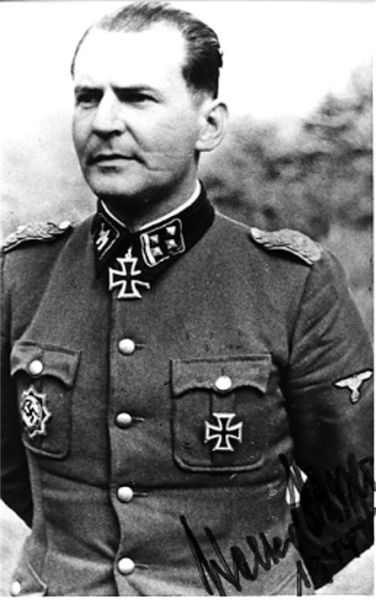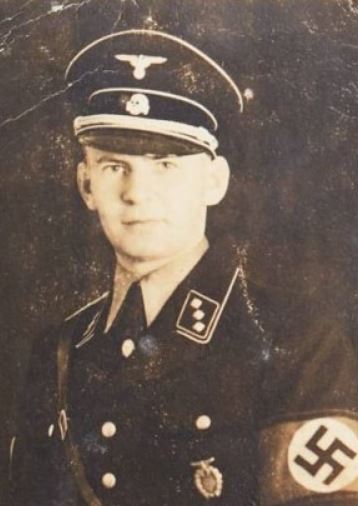Harzer, Walter (Waffen SS)
- Date of birth:
- September 29th, 1912 (Stuttgart-Feuerbach/Württemberg, Germany)
- Date of death:
- May 29th, 1982 (Stuttgart/Baden-Württemberg, Germany)
- Service number:
- SS-Nr.: 23.101 // NSDAP-Nr.: 477.371
- Nationality:
- German (1933-1945, Third Reich)
Biography
Promotions:
01.11.1931: SS-Anwärter
22.02.1932: SS-Mann
25.08.1933: SS-Rottenführer
10.12.1933: SS-Unterscharführer
00.00.1933: Gefreiter: 1933
01.07.1934: SS-Scharführer
23.12.1934: SS-Oberscharführer
25.04.1935: SS-Junker
05.05.1936: SS-Untersturmführer
04.11.1936: demoted to SS-Unterscharführer
29.09.1937: SS-Untersturmführer
30.01.1939: SS-Obersturmführer
16.05.1940: SS-Hauptsturmführer
20.04.1943: SS-Sturmbannführer
30.01.1944: SS-Obersturmbannführer
30.11.1944: SS-Standartenführer
20.04.1945: SS-Oberführer
Career:
00.11.1930: entered the NSDAP
01.11.1931: entered the SS
00.04.1933: joined the SS Politische Bereitschaft Württemberg
00.10.1933: Gefreiter, 13.(Württemburgisches) Infanterie-Regiment
00.03.1934: joined the SS-Verfügungstruppe, III. Sturmbann, SS-Standarte 1
00.04.1935-00.04.1936: SS-Junkerschule at Bad Tölz
00.05.1936-09.11.1936: SS-Ustuf, SD-Hauptamt
09.11.1936: SS-Usuf, Zugführer, 13. Sturm, SS-Standarte "Deutschland"
20.09.1937: SS-Ustuf, Zugführer, 12. Sturm, SS-Standarte "Deutschland"
15.12.1937: SS-Ustuf, Zugführer, 4. Sturm, SS-Standarte "Deutschland"
00.00.1938: SS-Ustuf, 9. Kompanie, SS-Standarte 'Deutschland'
01.04.1939: SS-Ostuf, Führer, 14. Sturm, SS-Standarte "Deutschland"
01.07.1939: SS-Ostuf, Chef, 9. Kompanie, SS-Standarte 'Deutschland' - campaign in Poland
01.11.1939: SS-Ostuf, Taktiklehrer, SS-Junkerschule Braunschweig
12.03.1941: SS-Hstuf, Taktiklehrer, SS-Unterführerschule Radolfzell
12.06.1941-01.05.1942: SS-Hstuf, Kdr, II. Bataillon, SS-Infanterie-Regiment 4
01.05.1942: Stab-Lehrgang, SS-Division "Reich"
11.07.1942-00.11.1942: SS-Hstuf, Stab, LVII. Panzerkorps
00.11.1942-00.02.1943: SS-Hstuf, Generalstab-Lehrgang
22.02.1943: SS-Hstuf, Ib, SS-Panzergrenadier-Division 10, later renamed the 10.SS-Panzer-Division 'Frundsberg'
10.04.1943-24.10.1944: SS-Stubaf, Ia, SS-Panzergrenadier-Division 9, later renamed the 9.SS-Panzer-Division 'Hohenstaufen' - Tarnopol then Caen
00.09.1944: SS-Ostubaf, Kdr, 9.SS-Panzer-Division 'Hohenstaufen' - the Netherlands
09.09.1944: Arnhem
17.09.1944-27.09.1944: Führer, Kampfgruppe, Sperrverband "Harzer" - Operation Market-Garden
10.10.1944-20.11.1944: SS-Ostubaf, Ia, Chef des Stabes, V. SS-Gebirgskorps
20.11.1944-28.11.1944: SS-Ostubaf, Divisionsführerlehrgang, Hirschberg / Jelenia Góra
29.11.1944-08.05.1945: SS-Ostubaf, Kdr, 4. SS-Polizei-Panzergrenadier-Division
08.05.1945: SS-Oberführer, surrendered near Wittenberge-Lenzen - US POW
Do you have more information about this person? Inform us!
- Period:
- Second World War (1939-1945)
- Awarded on:
- September 29th, 1939
- Period:
- Second World War (1939-1945)
- Awarded on:
- October 26th, 1941
- Period:
- Second World War (1939-1945)
- Awarded on:
- February 25th, 1942
- Period:
- Second World War (1939-1945)
- Awarded on:
- August 15th, 1942
- Period:
- Second World War (1939-1945)
- Awarded on:
- 1943
- Period:
- Second World War (1939-1945)
- Rank:
- SS-Obersturmbannführer (Lieutenant-colonel)
- Unit:
- Ia, 9. SS-Panzer-Division “Hohenstaufen”
- Awarded on:
- August 19th, 1944
- Period:
- Second World War (1939-1945)
- Rank:
- SS-Obersturmbannführer (Lieutenant-colonel)
- Unit:
- Ia, 9. SS-Panzer-Division “Hohenstaufen”, II. SS-Panzerkorps, Heeresgruppe B
- Awarded on:
- September 21st, 1944
“SS-Obersturmbannführer Harzer took over command of the 9. SS-Pz.Div. ‘Hohenstaufen’ from his original position as its first general staff officer (Ia). During the heavy defensive battles in the area St. Quentin-Cambrai-Valenciennes it had been formed into a Kampfgruppe from the remnants of the 9. SS-Pz.Div.
1.) On the night of the 01.-02.09.1944, near St. Quentin, SS-Obersturmbannführer Harzer received the task of protecting the German troops still located south of the city. He would do this by blocking all the roads from the southwest and west that led towards Cambrai from advancing enemy units. By the time the designated area was reached however strong enemy armoured forces had already overrun the planned blocking line in the southwest, and were already advancing from the south towards Cambrai. For this reason Harzer decided to conduct a swift bypassing march to the east, in which he would overtake the enemy by advancing north (see sketch) and try again at blocking the road that led to Cambrai from the south.
Harzer helped this operation to succeed despite a fuel shortage and the heavily worn out vehicles involved. Despite strong enemy armoured attacks that lasted the whole day Harzer held onto Cambrai, and also succeeded in successfully repulsing an enemy encirclement maneuver from the south that aimed to get into the eastern flank of the city. During the afternoon strong enemy tank forces launched a surprise advance from Arras (located to the northwest) against Cambrai. Only now did Harzer decide to pull his Kampfgruppe out of the city, having no units to spare from his weak forces. With his Kampfgruppe he managed to set up a new blocking line to the northwest (see sketch) under continual pressure from the enemy.
Although the enemy had meanwhile already begun to threaten the only retreat route to the northeast from both the south and northwest, SS-Obersturmbannführer Harzer (himself remaining in contact with the enemy until the last moment) succeeded in extracting his Kampfgruppe from Cambrai without notable losses. In the process he was cut off from the Kampfgruppe with the remnants of his staff. Now fully dependent on himself, he fought his way back to friendly forces over the course of 2 days and 2 nights, a period in which he was at times forced to employ clever ruses that even saw his group march amongst enemy columns. (Refer to the sketch for this).
Through his bitter steadfastness in this almost hopeless situation, Obersturmbannführer Harzer demonstrated outstanding bravery and flexibility before the enemy. He succeeded in tying down the lead enemy armoured spearheads in the Cambrai area for over 24 hours, and drawing the enemy to the northwest through his timely fighting retreat. In doing so he kept open the retreat route towards Mons for those combat elements of the II. SS-Pz.Korps that were still in the St. Quentin area.
2.) When English and American air-landing and parachute forces conducted their surprise landing in the Arnhem area, Obersturmbannführer Harzer received the order to take the handful of still available combat elements of the 9. SS-Pz.Div. and with these attack the enemy and destroy him. As his own Kampfgruppe was not sufficient for the carrying out of this mission, Harzer rallied all available soldiers in the Arnhem area from every branch of service. With these, as well as the reinforcing units from the Heer, Kriegsmarine, Luftwaffe and Waffen-SS, he created additional Kampfgruppen and led them immediately against the enemy airborne troops and Dutch terrorists that were already in control of a bridge quarter. Through his especially prudent and clever tactical leadership, he succeeded in engaging the enemy in difficult and ever-changing combat. In doing so he eventually brought the vital Arnhem bridge back into our hands in an undamaged state.
At the same time Harzer dispatched a Kampfgruppe for a deliberate attack against the other enemy group that had landed just to the west of Arnhem. It is exclusively due to his energy and personal bravery that the bitterly defending enemy was compressed into a tiny space within 48 hours, and thereafter forced to capitulate. Altogether this operation led by the divisional commander resulted in the capture of over 10000 prisoners as well as a large amount of war material.”
Sources
- Photo 1: Willi Schumacher Collection
- Photo 2:
- Photo: Willi Schumacher Collection
- Walter Harzer – Meda Militaria
- - FELLGIEBEL, W.P., Elite of theThird Reich, Helion & Company Limited, Solihull, 2003.
- PATZWALL, K. & SCHERZER, V., Das Deutsche Kreuz 1941-1945, Verlag Klaus D. Patzwall, Norderstedt, 2001.
- SCHNEIDER, J.W., Their Honor Was Loyalty!, Bender (R.James) Publishing, 1993.
- TIEKE, W., In the Firestorm of the Last Years of the War, J.J. Fedorowicz Publishing, Winnipeg, Canada, 1999.
- Defending Arnhem
- Microfilm Publication A3343. US National Archives.





















